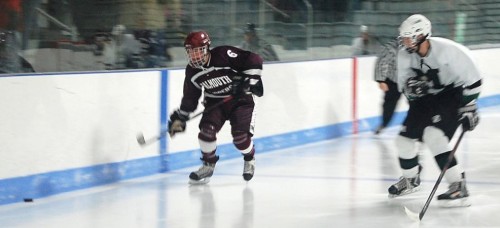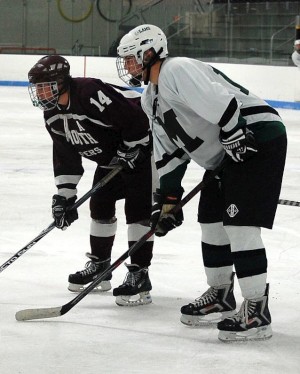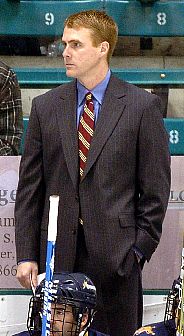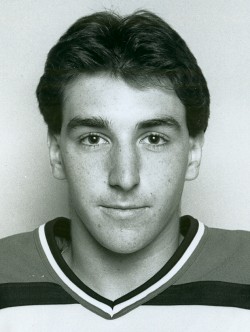Second in a series
The numbers are staggering …
• During the 1990s, head injuries or concussions in ice hockey increased by a whopping 269 percent.
• There are a reported 300,000 concussions suffered by athletes annually in the United States.
• According to the NCAA, the top two sports responsible for the largest number of concussions are women’s and men’s ice hockey; rugby, football and soccer round out the top five sports.
• In a players poll conducted in British Columbia in 2007, 60 percent of players surveyed between the ages of 15 and 20 stated they had suffered at least one concussion while playing the game.
From the outside, the numbers are disconcerting for any parent who has a son or daughter playing a contact or collision sport like ice hockey. And while the concern is always there, lying just below the surface as you watch the games and see other players sustaining injuries, it all comes home quickly when that player lying on the ice is your own son.
Brennan Quackenbush was a high school sophomore last season playing for the Marshfield (Mass.) High School varsity hockey team. Entering the season at 6-foot-4 and 190 pounds, Brennan was a solid defenseman with all the traits you want: skating, passing, shooting and physicality. Following a successful season as a freshman, expectations for Brennan and the team were high. The team took some time to find itself and the consistency needed for a solid run in the state tournament, but in February it was playing its best hockey, having upset the top-seeded team from Bridgewater-Raynham. The win over B-R set up a semifinal showdown with Archbishop Williams High School, where the winner had a high probability of playing for the state title in the Boston Garden.
On Thursday, March 4, the teams faced off at Gallo Arena in front of a raucous crowd spurred on by strong support from students, parents and friends. After ending the first period tied at 1-1, the teams continued the pace and physical tone in the second. There was a lot of physical play, with many high hits on players with and without the puck by both teams; the intensity was palpable on the ice and in the stands.

Brennan Quackenbush (right) lines up an opposing forward on the boards.
With about half the second period played, an innocuous play changed the game for Marshfield and Brennan. Following a brief offensive flurry in front of the Marshfield goal, the puck was cleared to the side boards, where Brennan took possession and made a clean breakout pass to a teammate at neutral ice. As the play moved toward the other goal, Brennan was checked by an opposing player with his stick and hands, directly making contact to his chin. The hit was from the blind side and resulted in Brennan’s head making further contact with the glass and boards as he fell to the ice. He did not hit his head on the ice but the damage was done.
Everything faded to yellow.
Brennan knew immediately he had sustained a head injury, and while he was attended to on the bench by an athletic trainer assigned to the tournament game, it was determined quickly that he would not be able to return to the game based on his symptoms, which included an intense headache along with the yellowed vision. As the period ended, Brennan was escorted to the locker room and two parents ran from the stands to attend to their son.
Bill Quackenbush and Kate Costello, Brennan’s parents, immediately found their way to ice level to confer with the coaches, trainer and Brennan between periods. Every parent’s nightmare of their child being injured was very real, and more so when it was obvious that it was a head injury. While Brennan’s vision had returned to normal, his headache was intense. He remained rinkside to watch the remainder of the game, a heartbreaking 2-1 loss, and went immediately home after the game to rest quietly without any activity or schoolwork.
Next began the series of doctor’s visits, testing and evaluation which, for the uneducated, truly shed much light on the long-term effects and severity associated with head injuries in young athletes.
Not an Isolated Concern
Marshfield is a small community — population about 25,000 — on the coast approximately 35 miles south of Boston. The high school athletic program is extremely successful and last season saw the football team win the state title in its fourth straight appearance at Gillette Stadium. With such strong athletic teams, injuries are a consistent part of the sports seasons.
“This past school year we saw 58 concussions among all of the boys and girls teams,” said Carolyn Rains, a high school nurse. “Those are just the reported ones, as it is probably a significantly higher number than the concussions that are obvious or reported.”
In light of the number of events suffered by Marshfield athletes, the local sports boosters purchased software to be administered in the school by the nurse as a mandatory component of team participation for all athletes competing in contact or collision sports. The intent is to establish a baseline of brain activity for each athlete so subsequent tests can objectively assess a return to normal brain function and the appropriate time to return to the field of play — ultimately taking the decision out of the hands of the player, parents and coaches.
The ImPACT test (Immediate Post-concussive Assessment and Cognitive Test) is a concussion management tool that was developed after over 10 years of research. It is a user-friendly, computer-based test that accurately measures concussive symptoms as well as verbal and visual memory skills. The test is self-guided and covers several areas that include impulse control, reaction time and visual motor speed in addition to the verbal and visual memory skills. Athletes need to return to the values established in their baseline in order to be assessed as recovered from the head injury; this testing and waiting can be the most trying of times for the athlete and parents alike.
While Brennan’s symptoms began to subside after Day 5, it was recommended that he be seen by Dr. Janet Kent of the rehabilitation group at South Shore Hospital in Weymouth, Mass. Kent has developed a specialty for treating young athletes with concussions, and her initial evaluation of Brennan resulted in a recommendation for him to continue to rest, avoid any significant stimulation of the brain and limit his ongoing school activities. After one week, Brennan returned to school but was still dealing with headaches, light sensitivity, noise sensitivity and an overall sense of “mental fogginess.”
Both Bill and Kate had real concerns about Brennan’s recovery and most importantly his ability to return to normal function and sustain his schoolwork. Every day brought more questions and an increasing frustration level by Brennan, who was struggling with his focus and ability to do schoolwork — all with no physical activity to release his growing frustration.
Two weeks following his injury, Brennan returned to school but had trouble completing a full day and continued to display symptoms from the concussion. In order to address the pressing psychological impact of the injury on Brennan and his parents, Kent referred the family on to Dr. Neal McGrath, a clinical neuropsychologist with Sports Concussion of New England located in Boston. McGrath conducted an assessment which included a review of prior ImPACT activity, clinical notes from Kent and interviews with Brennan and his parents. It was during the discussion with Brennan that information about other unreported events came to light and created additional concerns for all involved.
A Long Road Back
During the interview, Brennan recounted an experience from a game early in the season where he was hit by an opponent while his head was down. He saw yellow for approximately five seconds but it cleared and he stated he felt normal. He had no other postgame symptoms and did not report the event to anyone — a pattern that many young athletes repeat for fear of not being able to play or being taken out of the lineup for an extended period of time.
Of greatest concern to Bill and Kate was their son returning to “normal” functionality. Both parents felt that Brennan was foggy, distracted and disconnected. It seemed to manifest itself most obviously in his schoolwork, where prior to the injury Brennan was a solid A/B student but post-injury had slipped to a B/C level, noting significant memory issues in preparation of homework and test assignments.
McGrath’s evaluation in mid-April led to several key recommendations. Brennan was to try to maximize his sleeping hours in order to allow his brain to rest. He was to refrain from all intense physical activity or any activity that causes a return of any symptoms. Additionally, Brennan was provided with a number of accommodations in school in order for him to complete course work needed for his matriculation to his junior year. Lastly, ongoing testing with additional ImPACT tests would be used to further benchmark his progress and any future need for neuropsychological testing.
One hit had Brennan struggling at school, missing the lacrosse season — where he was a varsity long stick defender — curtailing any physical activities, including working out, and creating much stress about when this was going to get better.
According to Kent, there really is no timetable for a recovery from a concussion. “All concussions for every individual are different,” Kent said. “Symptoms will vary among individuals, and the brain’s ability to recover is different for everyone, especially relative to the location and severity of the injury. The advantage of using tools like the ImPACT test is that it provides a baseline when taken prior to any head trauma that allows a clearly defined intra-patient comparison for evaluating the brain’s cognitive recovery from the injury.”
As the school year came to an end, Brennan managed, with great effort, to complete his sophomore year. Additional support, including tutors, were provided to help provide direct learning outside the classroom environment, and generally his grades have returned to the prior levels of being an A/B student. This stressful close to the school year was difficult not only for Brennan but also his parents, who have shared their son’s frustration, anxiety and concerns over returning to a normal life — one that will include sports.
“I look at everything he does now more critically,” said Brennan’s mother, Kate. “When he forgets things or seems moody or exceptionally quiet I wonder if it is still related to the concussion and is he all right. You always wonder how much of his emotions and actions are related more to his being a 16-year-old boy or still dealing with the aftermath of his injury. I worry about everything, but this is really hard because it’s not like a broken bone that you can take an X-ray and know when it is healed — you just don’t know what will bring on symptoms or what will happen the next time he gets hit and what the long-term effects are.”
Brennan returned to see McGrath following the end of the school year. During the last few weeks of school, Brennan took additional ImPACT tests to determine whether he was truly back to normal; after several tests, Brennan remains unable to pass all of the components of the computer generated test.
Turning a Corner
During his visit with McGrath in late June, Brennan noted several things that had him feeling back to normal. He finished the school year solidly, his sleep has been good — not restless — and he has noticed no return of symptoms even when playing video games or half-court basketball with his friends. He passed his driving test and got his license and appears to be a focused and conservative driver — at least with his family — and he has obtained a part-time job at a local car service shop.

At 6-foot-4 and 190 pounds, Brennan was a solid defenseman with all the traits you want: skating, passing, shooting and physicality.
Despite all of the positives and an obvious return to his “being himself,” Brennan is still actively recovering from his injury sustained in early March. Based on his being symptom-free, Brennan’s restrictions have been reduced and he is now working out four days per week and has recently begun skating one night a week with no contact drills or game play involved. He will be tracked by the concussion specialists until his cognitive test scores are fully back into expected ranges; until then, his return to contact sports is on hold.
Four full months have passed since “the hit,” and while there is a light at the end of the tunnel, there is still additional healing that needs to take place. For Brennan, and most teenagers who feel they are bulletproof, progress is slow and he wants things to progress faster. For Brennan’s parents, they just want to be sure that their son is OK in every sense of the word and that his return to normalcy doesn’t include any lingering effects. Keys to both are the ongoing communication among all parties and the education provided by the nurses and physicians treating Brennan, as most of the information to parents and players alike is new and provides a comprehensive understanding of the nature of head trauma and recovery. The unfortunate part is that unless you have a son or daughter going through the recovery from a concussion or head trauma there is little information available that most school personnel understand relative to the effects concussions have on students’ personalities and ability to complete even simple assignments.
In looking back at the events of March 4, there are several key items that bear reflection:
• First, there was the good fortune of a licensed medical trainer being assigned to attend the state tournament game. Unfortunately, this is not always the case. According to studies, many coaches and officials at the high school and college level cannot diagnose the symptoms of a concussion objectively and can inadvertently put athletes at additional risk by having them continue to play.
• Second, given the availability and access to the ImPACT test, it seems logical that protecting our young athletes from head trauma and concussions by allowing them to fully recover will better serve the lifetime goals desired for our young student-athletes.
• Third, it is obvious that the education available for athletic departments, athletes and parents regarding concussions needs to be more widely distributed and talked about.
• Fourth, can we direct coaches, players governing organizations and officials to eliminate and punish the types of hits that cause these injuries?
• Fifth, can equipment manufacturers address the forces and impacts created by full-speed collisions in today’s sports like ice hockey to better protect the participants?
The game of ice hockey has not changed in relation to the size of the rinks (usually 200 feet by 85 feet) it is played on. There really is no question that today’s players, most of whom specialize in a single sport for 12 months a year starting at a young age, are utilizing specialized training methods, nutrition and on-ice games and drills. They are bigger and faster today, and the resulting collisions bear greater impact either in the open ice or against the rigid boards and glass. In Brennan’s case, it was the combination of the two types of hits that caused the injury.
In 1979-80, the NCAA mandated the use of full-face cages in order to protect hockey players from face and eye injuries. While data supports evidence of fewer face and eye injuries due to use of the cages, concussion rates are clearly up and continue to rise. I believe that the cages have been a major contributor to those statistics.
Years ago while attending Middlebury from 1977 to 1981, I had the privilege of playing on the hockey team and witnessed first-hand the impact of the cages that were employed during the last two years of my playing at the college level. In essence, it was a four year lab-study with two years of play without the face protection followed by two years of full cages with essentially the same demographic population of athletes. Prior to use of face cages, there was a mutual respect among the players that limited any stick or body contact to the head or face area. While there were some incidents, they seemed to be mostly related to puck contact, deflections or inadvertent stick contact as opposed to targeting the head of an opponent.
During my final two years, I witnessed a change in the game where hitting was no longer about puck possession but more about intimidation and sending a message with brutal physicality to the opposition. The cages gave players a sense of being invulnerable and, as a result, hip checks and shoulder checks that were so common now turned to fists and sticks to the head in an attempt to rattle the opposition. Add to the mix the protective levels of mouthguards and helmets — which have only recently substantially improved — with what is deemed to be legal by officials of varying degrees of ability and you have a recipe for continuing the trend of increasing numbers of head injuries in the sport.
While half-shields leave part of the face exposed to inadvertent stick and puck contact, the air of invincibility and lack of respect for the head could be mitigated by their use in place of full cages, particularly at the elite levels of play where the speed and size play into the severity of the impact.
Additionally, penalizing the offending player with a match penalty may curtail the extent of players pursuing the debilitating hits on opponents, but perhaps one should consider the potentially stronger impact of an offending player sitting out for as long as the player sustaining the concussion from an illegal hit is unable to play.
For Brennan Quackenbush, this summer has been dedicated to becoming a bigger, stronger and faster athlete in order to be better equipped to deal with the types of hits that permeate today’s game. His road to recovery has been long, frustrating and, at times, scary from the unknowns associated with concussions.
Kate and Bill are happy to have their son back — seemingly in his right mind. For Brennan, there is the promise of being cleared for contact after a full five months has elapsed from the injury. Ultimately, having his life back fully, being a successful student and playing a game he loves will put all of this behind him quickly.
It has been a long and challenging spring but to quote Janis Joplin, “It’s summertime and the living is easy.”
I would like to acknowledge the information contained in Concussions in Hockey: There is Cause for Concern by D. Goodman, M. Gaetz and D. Meichenbaum, along with Current Concepts in Concussion Diagnosis and Management in Sports: A Clinical Review by D. Brooks and B. Hunt, which was used to provide additional background and statistical information. Also, I appreciate the clinical reports and documentation provided by Drs. Janet Kent and Neal McGrath (www.sportsconcussion.net) Finally, I appreciate and send special thanks for the input and candor of my friend Bill Quackenbush, my wife Kate Costello and stepson Brennan Quackenbush in the preparation of this article.



